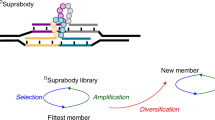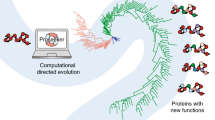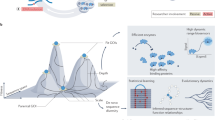Abstract
We have developed a simple method for exploring nucleic acid sequence space by nonhomologous random recombination (NRR) that enables DNA fragments to randomly recombine in a length-controlled manner without the need for sequence homology. We compared the results of using NRR and error-prone PCR to evolve DNA aptamers that bind streptavidin. Starting with two parental sequences of modest avidin affinity, evolution using NRR resulted in aptamers with 15- to 20-fold higher affinity than the highest-affinity aptamers evolved using error-prone PCR, and 27- or 46-fold higher affinities than parental sequences derived using systematic evolution of ligands by exponential enrichment (SELEX). NRR also facilitates the identification of functional regions within evolved sequences. Inspection of a small number of NRR-evolved clones identified a 40-base DNA sequence, present in multiple copies in each clone, that binds streptavidin. Our findings suggest that NRR may enhance the effectiveness of nucleic acid evolution and the ease of identifying structure–activity relationships among evolved sequences.
This is a preview of subscription content, access via your institution
Access options
Subscribe to this journal
Receive 12 print issues and online access
$209.00 per year
only $17.42 per issue
Buy this article
- Purchase on Springer Link
- Instant access to full article PDF
Prices may be subject to local taxes which are calculated during checkout






Similar content being viewed by others
References
Wilson, D.S. & Szostak, J.W. In vitro selection of functional nucleic acids. Annu. Rev. Biochem. 68, 611–647 (1999).
Bittker, J.A., Phillips, K.J. & Liu, D.R. Recent advances in the in vitro evolution of nucleic acids. Curr. Opin. Chem. Biol. 6, 367–374 (2002).
Kopylov, A.M. & Spiridonova, V.A. Combinatorial chemistry of nucleic acids: SELEX. Mol. Biol. 34, 940–954 (2000).
Tuerk, C. & Gold, L. Systematic evolution of ligands by exponential enrichment: RNA ligands to bacteriophage T4 RNA polymerase. Science 249, 505–510 (1990).
Cadwell, R.C. & Joyce, G.F. Mutagenic PCR. PCR Methods Appl. 3, S136–S140 (1994).
Vartanian, J.P., Henry, M. & Wain-Hobson, S. Hypermutagenic PCR involving all four transitions and a sizeable proportion of transversions. Nucleic Acids Res. 24, 2627–2631 (1996).
Piganeau, N., Jenne, A., Thuillier, V. & Famulok, M. An allosteric ribozyme regulated by doxycyline. Angew. Chem. Int. Ed. 39, 4369–4373 (2000).
Santoro, S.W., Joyce, G.F., Sakthivel, K., Gramatikova, S. & Barbas, C.F. RNA cleavage by a DNA enzyme with extended chemical functionality. J. Am. Chem. Soc. 122, 2433–2439 (2000).
Tsang, J. & Joyce, G.F. Specialization of the DNA-cleaving activity of a group I ribozyme through in vitro evolution. J. Mol. Biol. 262, 31–42 (1996).
McGinness, K.E., Wright, M.C. & Joyce, G.F. Continuous in vitro evolution of a ribozyme that catalyzes three successive nucleotidyl addition reactions. Chem. Biol. 9, 585–596 (2002).
Rao, J., Lahiri, J., Isaacs, L., Weis, R.M. & Whitesides, G.M. A trivalent system from vancomycin.D-ala-D-Ala with higher affinity than avidin.biotin. Science 280, 708–711 (1998).
Meyerhans, A., Vartanian, J.P. & Wain-Hobson, S. DNA recombination during PCR. Nucleic Acids Res. 18, 1687–1691 (1990).
Paabo, S., Irwin, D.M. & Wilson, A.C. DNA damage promotes jumping between templates during enzymatic amplification. J. Biol. Chem. 265, 4718–4721 (1990).
DeStefano, J.J. Kinetic analysis of the catalysis of strand transfer from internal regions of heteropolymeric RNA templates by human immunodeficiency virus reverse transcriptase. J. Mol. Biol. 243, 558–567 (1994).
Ness, J.E., Del Cardayre, S.B., Minshull, J. & Stemmer, W.P.C. in Advances in Protein Chemistry, Vol. 55 (ed. Arnold, F.H.) 261–292 (Academic Press, San Diego, CA, 2001).
Stemmer, W.P. Rapid evolution of a protein in vitro by DNA shuffling. Nature 370, 389–391 (1994).
Volkov, A.A. & Arnold, F.H. Methods for in vitro DNA recombination and random chimeragenesis. Methods Enzymol. 328, 447–456 (2000).
Zhao, H., Giver, L., Shao, Z., Affholter, J.A. & Arnold, F.H. Molecular evolution by staggered extension process (StEP) in vitro recombination. Nat. Biotechnol. 16, 258–261 (1998).
Sieber, V., Martinez, C.A. & Arnold, F.H. Libraries of hybrid proteins from distantly related sequences. Nat. Biotechnol. 19, 456–460 (2001).
Kolkman, J.A. & Stemmer, W.P. Directed evolution of proteins by exon shuffling. Nat. Biotechnol. 19, 423–428 (2001).
Lutz, S., Ostermeier, M., Moore, G.L., Maranas, C.D. & Benkovic, S.J. Creating multiple-crossover DNA libraries independent of sequence identity. Proc. Natl. Acad. Sci. USA 98, 11248–11253 (2001).
Tsuji, T., Onimaru, M. & Yanagawa, H. Random multi-recombinant PCR for the construction of combinatorial protein libraries. Nucleic Acids Res. 29, E97 (2001).
Ostermeier, M., Shim, J.H. & Benkovic, S.J. A combinatorial approach to hybrid enzymes independent of DNA homology. Nat. Biotechnol. 17, 1205–1209 (1999).
Wedel, A.B. Fishing the best pool for novel ribozymes. Trends Biotechnol. 14, 459–465 (1996).
Upcroft, P. & Healey, A. Rapid and efficient method for cloning of blunt-ended DNA fragments. Gene 51, 69–75 (1987).
Engler, M.J. & Richardson, C.C. in The Enzymes, Vol. 15 (ed. Boyer, P.D.) 1–29 (Academic Press, New York, 1982).
SantaLucia, J. Jr. A unified view of polymer, dumbbell, and oligonucleotide DNA nearest-neighbor thermodynamics. Proc. Natl. Acad. Sci. USA 95, 1460–1465 (1998).
Pagratis, N.C. et al. Potent 2'-amino-, and 2'-fluoro-2'-deoxyribonucleotide RNA inhibitors of keratinocyte growth factor. Nat. Biotechnol. 15, 68–73 (1997).
Ekland, E.H., Szostak, J.W. & Bartel, D.P. Structurally complex and highly active RNA ligases derived from random RNA sequences. Science 269, 364–370 (1995).
Kuwabara, T., Warashina, M. & Taira, K. Allosterically controllable ribozymes with biosensor functions. Curr. Opin. Chem. Biol. 4, 669–677 (2000).
Soukup, G.A. & Breaker, R.R. Nucleic acid molecular switches. Trends Biotechnol. 17, 469–476 (1999).
Bogarad, L.D. & Deem, M.W. A hierarchical approach to protein molecular evolution. Proc. Natl. Acad. Sci. USA 96, 2591–2595 (1999).
Schuler, G.D., Altschul, S.F. & Lipman, D.J. A workbench for multiple alignment construction and analysis. Proteins 9, 180–190 (1991).
Acknowledgements
Funding was provided by US National Science Foundation CAREER award MCB-0094128 and by Harvard University. J.A.B. is a Howard Hughes Medical Institute predoctoral fellow. B.V.L. was supported by the Harvard College Research Program. We are grateful to P. Patten (Maxygen, Redwood City, CA) for helpful discussions.
Author information
Authors and Affiliations
Corresponding author
Ethics declarations
Competing interests
The authors declare no competing financial interests.
Rights and permissions
About this article
Cite this article
Bittker, J., Le, B. & Liu, D. Nucleic acid evolution and minimization by nonhomologous random recombination. Nat Biotechnol 20, 1024–1029 (2002). https://doi.org/10.1038/nbt736
Received:
Accepted:
Published:
Issue Date:
DOI: https://doi.org/10.1038/nbt736
This article is cited by
-
Barcoded DNA origami structures for multiplexed optimization and enrichment of DNA-based protein-binding cavities
Nature Chemistry (2020)
-
Identification and characterization of nucleobase-modified aptamers by click-SELEX
Nature Protocols (2018)
-
Laser ablation-based one-step generation and bio-functionalization of gold nanoparticles conjugated with aptamers
Journal of Nanobiotechnology (2010)
-
In vitro 'sexual' evolution through the PCR-based staggered extension process (StEP)
Nature Protocols (2006)
-
FluMag-SELEX as an advantageous method for DNA aptamer selection
Analytical and Bioanalytical Chemistry (2005)



